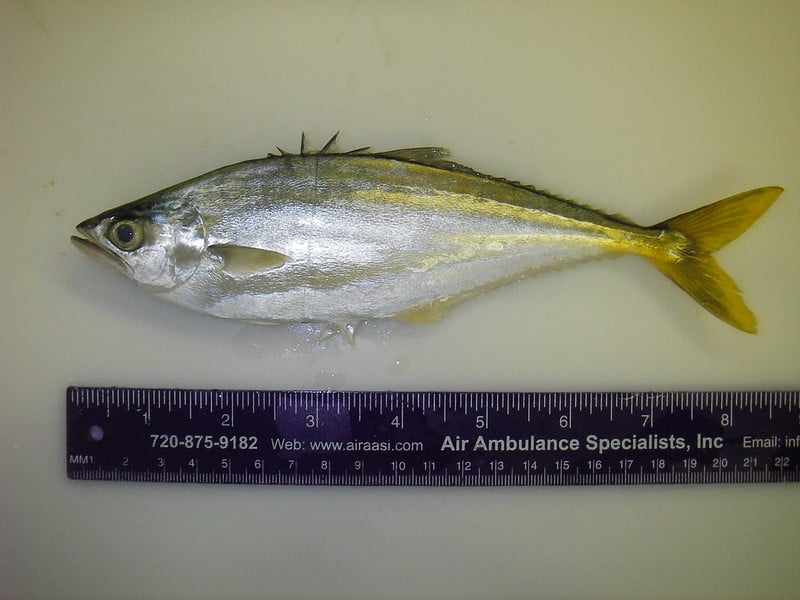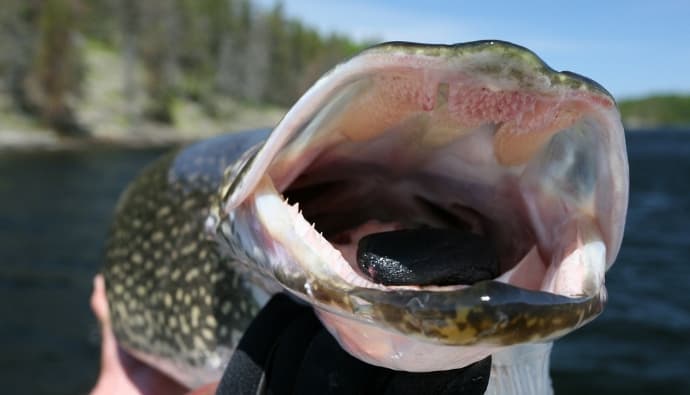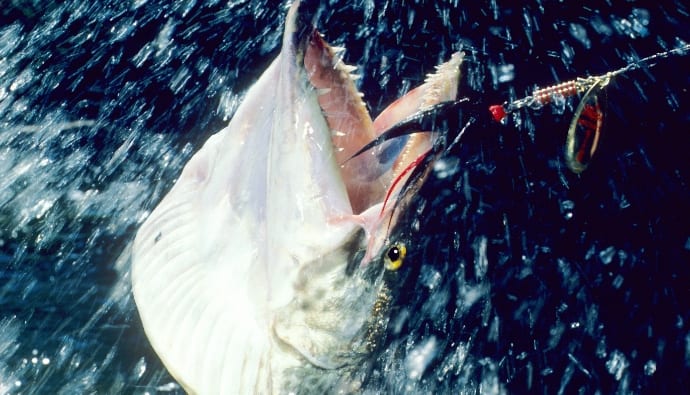Why is the leatherjacket fish dangerous for humans and how can you catch it?
Find out answers to these questions and much more in this comprehensive guide about this excellent table fish!
Here’s the ultimate guide to leatherjacket fishing.
Overview

Also known as leatherjack, leatheries, skipjack, and zapatero, this fish belongs to the jack fish family called Carangidae and may also refer to other species in the family. While it cannot kill you if you get pricked by its finlets, the sharp spines on the dorsal and anal fins can cause painful punctures.
There are over 20 species of leatherjackets around NSW waters and each has its own distinct appearance.
For example, the horseshoe leatherjacket is bright blue, green, and yellow in color and has a horseshoe pattern on the tail while the fan belly is light brown in color and has a fan-shaped fin running under the chin and along the belly.
But each one has a small mouth with beaklike teeth, sandpapery skin, and a single serrated spine on the top.
Leatherjacket Facts
| Scientific Name | Oligoplites saurus |
| Common Name(s) | Leatherjacket |
| Family | Carangidae |
| Identifying Characteristics | Has a small mouth with beaklike teeth, sandpapery skin, and a single serrated spine on the top. |
| Depth Range | 200 m |
| Habitat | Can be found in the Pacific, Mediterranean, and Western Atlantic oceans. |
| Limits | Check your local regulations |
| Largest Recorded | N/A |
| Status | No |
Where to Catch Leatherjacket
Small leatherjackets can be found in estuaries and around harbors that have plenty of reef and weed cover. Larger ones can be found swimming in offshore waters as deep as 200m.
You can also score around wharves, jetties, wrecks, and rock walls because that’s where the fish remains safe from predators. Some species of leatherjacket fish can also be found deeper than 200m underwater, such as the Unicorn and the Chinaman variety.
How to Catch Leatherjacket
Most anglers catch leatherjackets by chance when they are fishing for other fish. But if you are actively fishing for the species, you need to keep a few things in mind. For one thing, remember that all leatheries have small mouths, so the bait should be small enough to sit on the bend of the hook (which should be an 8 to the 12-long shank for offshore).
Cut up pilchard, tuna, mullet, or slimy mackerel for bait the fish cannot resist. Plus, make sure that the sinker is just off the bottom and that the leader’s length from the mainline is short. As for gear, go for ultra-light graphite spin rods that are about 6’6” to 7’ in length and which can handle braided lines that can withstand a 2 to 4 kg test. Plus, use fluorocarbon leaders that can handle over 5 to 15lb of weight.
Leatherjacket Fishing Tactics
- Before fishing for leatherjacket fish, rub some aniseed oil on your hands. This will encourage shy fish to feed actively but make sure that it is legal to do so first.
- Use long shank hooks to prevent bite-offs, to ensure the small bait you use can remain on the bend, and to ensure that you can remove the fish easily.
Leatherjacket Fishing Tips
- Salt down the bait a couple of days before fishing for leatherjackets offshore. This will toughen up the skin and flesh while keeping the bait juicy.
- Use a paternoster rig with a sinker on the bottom and 1 or 2 hooks above. This is by far the best rig setup to catch leatherjacket fish.
Leatherjacket Seasons
Leatherjackets can be found year-round and most are active during rising tides and in low light conditions, i.e., early in the morning and just before sunrise. Many also feed actively throughout the day and night, but that is also dependent on tidal movements.
So if you’re into fishing at night, take the tidal movements into consideration before going out.
How to Clean Leatherjacket
- Place the leatherjacket fish on a clean surface and use a sharp filleting knife to make an incision behind the spike and cut through the backbone till you hit the soft flesh. Do not slice off the head with the knife.
- Hold the head in one hand and steady the body with the other and rip downwards to remove the head, taking the guts with it.
- Make a small cut in the skin on top of the fish where you made the first cut so you can grab onto the skin.
- Peel the skin towards the tail. This should come off easily.
- Take a fillet off either side if the leatherjacket is large enough or cook the cleaned fish whole if it is a small one.
How to Cook Leatherjacket
- Chop the cleaned leatherjacket into 4 pieces.
- Make a marinade by mixing 10 tablespoons of soy sauce with 6 tablespoons of mirin, 2 cloves of grated garlic, 3 tablespoons of grated ginger, 2 pinches of white pepper, a pinch of salt, 1 teaspoon of white sugar, and 1 teaspoon of sesame oil.
- Pour the marinade over the fish and coat evenly.
- Cover and refrigerate for half an hour.
- Remove the fish from the refrigerator and toss in plain flour to coat evenly.
- Heat 2 cups of vegetable oil in a deep frying pan and fry the fish in batches till golden brown and cooked through.
- Serve with lime wedges and green salad.
Listen to Why You Need to STOP Eating Fresh Fish on the Cast & Spear Podcast
FAQs
Yes, but they are so tiny that you wouldn’t know it. All species of leatherjackets are covered with minuscule scales that make the skin feel sandpapery and rough.
The leatherjacket fish is venomous and it carries poison in its dorsal and anal fin. The spines can inflict painful wounds that are known to be worse than those inflicted by the stingray.
The maximum length that the fish can achieve is 13.8 inches but most don’t grow more than 10.6 inches.
Insider Advice
The best places to fish for leatherjackets can be found around Sydney, Australia, as well as around public wharves, like the one at Luna Park or the Spit Bridge in Middle Harbor.
Do you know of spots that are great for leatherjacket fishing or strategies that worked for you? Share in the comments section and do share this guide if you liked it.




 Facebook
Facebook YouTube
YouTube








